Travel Blogging is not only a great way to make money online, but it’s also a great way to explore the world. This blog will show you how to start your own travel blog and make money online in 2024.
You will learn how to choose your travel blog’s niche, create a travel blog in WordPress and write blog posts. You will also learn how to promote and monetize your travel blog to get traffic and make money.
You will learn how to start a travel blog from scratch by the end of this guide.
If you have any questions along the way, just drop a comment and I will help you out.
Let’s get started!
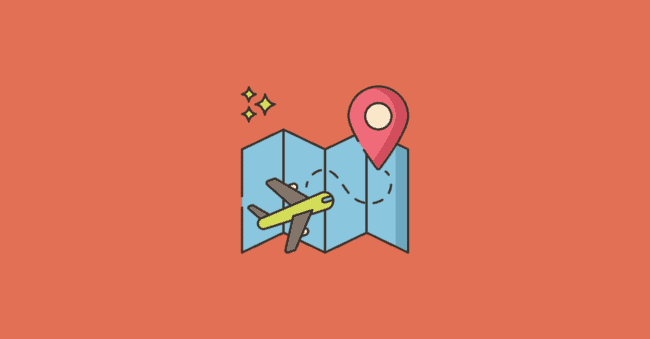
How to Start a Travel Blog in 7 Steps
- Define Your Travel Blogging Goals
- Choose a Travel Niche
- Pick & Register a Blog Domain Name
- Setup WordPress
- Write & Publish Blog Posts
- Promote Your Travel Blog
- Monetize & Make Money
1. Define Your Travel Blogging Goals
The first step to starting a travel blog is to define your goals. What do you want to achieve with your travel blog?
- Do you want to make money from blogging?
- Do you want to explore the world and write about your experiences?
- Do you want to help others plan their travels?
Your goals will determine the direction of your travel blog.
If you want to make money from blogging, then you will need to focus on creating monetizable content. This includes writing sponsored posts, reviews, and affiliate marketing.
If you want to explore the world and write about your experiences, then you will need to focus on building an audience and writing interesting and engaging content.
If you want to help others plan their travels, then you need to focus on providing helpful tips and advice.
You can have multiple goals for your travel blog. But no matter what your goals are, make sure they are specific, achievable, and measurable.
What is a Travel Blog?
A travel blog is a blog that focuses on travel-related topics. Travel bloggers write about their experiences traveling, offer travel tips and advice, and provide information on different destinations.
Why Start a Travel Blog?
There are many reasons to build a travel blog.
If you love to travel, then a travel blog is a great way to share your experiences with others.
A travel blog can also be a great way to make money online. You can make money from sponsored posts, affiliate marketing, and through other monetization methods.
You can also land sponsorship deals where a company pays you to travel to their destination and write about it.
A travel blog can also help you land a job in the travel industry. Many professional travel bloggers have gone on to work as travel writers, tour guides, and more.
The benefits of starting a travel blog include:
- Make money travelling
- Build an audience of loyal readers
- Get freebies and travel opportunities
- Get jobs in the travel industry
- Share your travel experiences with the world
No matter what your reason is for starting a travel blog, the key is to start with a clear focus and purpose.
How much money can you make from Travel blogging?
The median ad income of a blog with 100 posts that gets traffic is $2815 per month. There is no limit to how much money you can make from travel blogging. How much you make will depend on your traffic, the methods you use to monetize your blog, and your sponsored post rates. The travel blog Living the Dream made $8,450 in a single month.
2. Choose a Travel Niche
The next step is to choose a travel niche. A niche is a specific topic or subject that you will be writing about on your travel blog.
Why choose a niche?
Focusing on a specific niche will make it easier to build an audience and make money from your travel blog.
It’s much easier to become an expert in a specific area than it is to become an expert on everything related to travel.
When you focus on a specific niche, you can build a loyal following of readers who are interested in that specific topic.
How to choose a travel blog niche?
The best way to choose a travel blog niche is to focus on a topic that you are passionate about.

What are you passionate about when it comes to travel? Do you love adventure travel? Are you passionate about food and drink? Do you love luxury travel?
Your niche should be something that you can write about for years to come. It should be something that you are interested in and passionate about.
Some popular travel niches include:
- solo female travel
- budget travel
- luxury travel
- family travel
- adventure travel
- food and drink
- river cruises
- accessible travel
- corporate travel
- destination travel
- groups
- heritage travel
- ocean cruises
- medical tourism
- MICE (Meetings, Incentives, Conventions/Conferences, Events)
- weddings/honeymoons
- wellness travel
When choosing a niche, make sure it is something you are passionate about. It should also be something you can write about consistently.
Examples of Travel Blogs
Sometimes looking at other travel blogs will help inspire ideas of your own. Here are some of the more popular travel blogs:
1. Nomadic Matt
The blog Nomadic Matt focuses on helping people travel better for less. The blog is run by Matt Kepnes, who has been traveling since 2004.
The blog covers a wide range of topics related to travel, including budget travel tips, how to find cheap flights, and how to make the most of your travels.
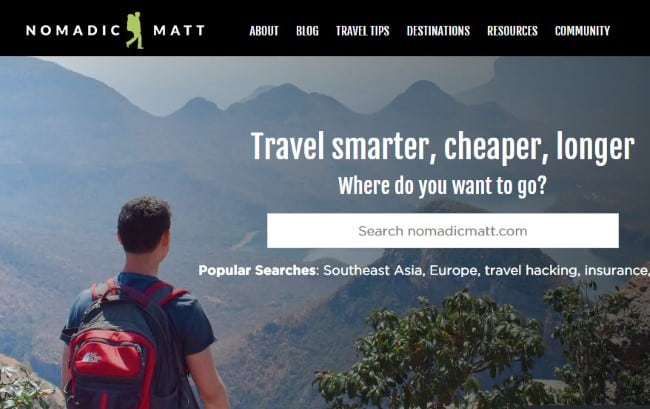
2. Lonely Planet
Lonely Planet is one of the most popular travel guides in the world. The company also has a popular travel blog, which covers a wide range of topics related to travel.
The blog covers everything from destination guides to travel news and tips.
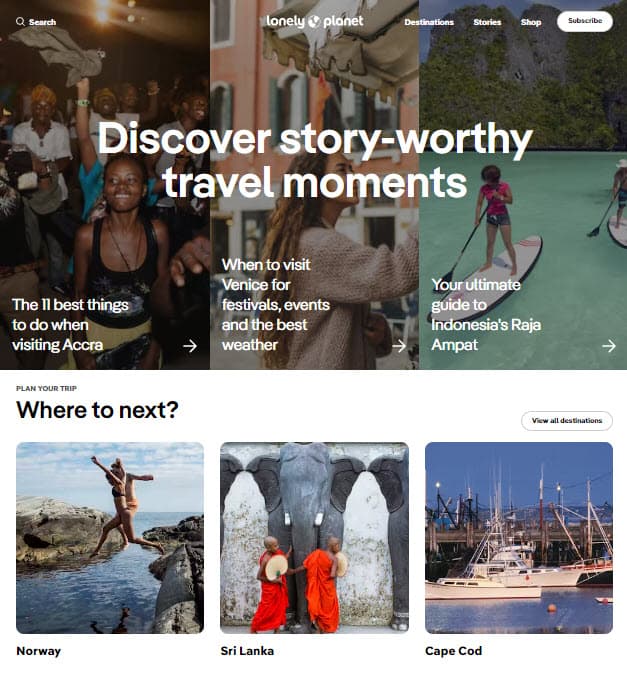
3. Mapping Megan
Mapping Megan is a popular travel blog focusing on solo female travel. The blog is run by Megan Jerrard, who has been traveling since 2007.
The blog covers a wide range of topics related to solo female travel, including how to travel safely as a woman, how to meet other travelers, and how to make the most of your travels.

4. The Broke Backpacker
The Broke Backpacker is a popular travel blog focusing on budget travel. The blog is run by Will Hatton, who has been traveling since 2009. The blog covers a wide range of topics related to budget travel, including how to find cheap accommodation, how to find cheap flights, and how to save money while traveling.
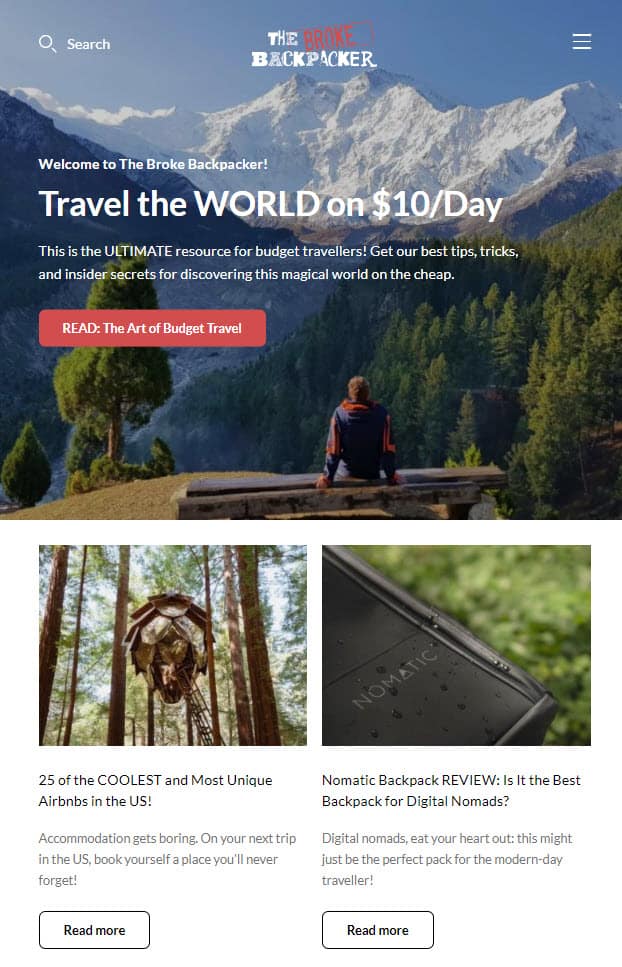
5. Travel Freak
Travel Freak is a popular travel blog by Jeremy that covers a wide range of topics related to travel. Jeremey has been traveling for more than a decade, and his blog showcases his truly extraordinary travel photos.
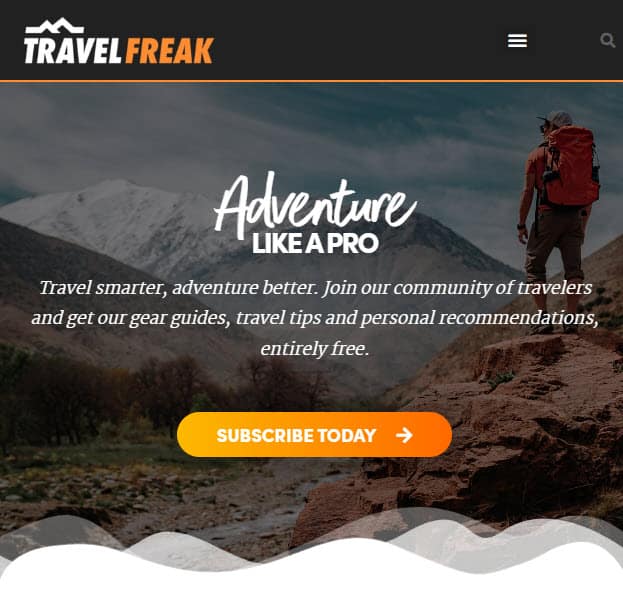
Check if Your Niche Is Profitable
Once you’ve chosen your niche, it’s important to check if it is profitable. How do you know if your niche is profitable?
The best way to find out is to research other travel blogs in your niche and see how they are making money.
Are they selling products? Are they running ads? Are they sponsored by brands?
You can also research your niche on Google and see if there are any advertisers running ads related to your niche.
If there are, then that is a good sign that you can make money from your niche.
3. Pick & Register a Blog Domain Name
Once you have chosen your niche, it is time to brainstorm a few names for your food blog.
We recommend you keep your blog’s name to two words (Example: Nomadic Matt). One of the two words should be a keyword from your niche. The other word can be something that makes your website brandable. For example, I started my blog to teach people how to make passive income, so I have named it Passive Book.
Here are some of the words that you can mix and match into your travel blog name:
- Wander
- Backpacker
- Nomad
- Journey
- Voyage
- Adventure
- Foodie
- Drinker
- Luxury
- Budget
- Cheap
- Saver
- Traveler
- Guide
You can also use a Business Name Generator to brainstorm the name of your blog.
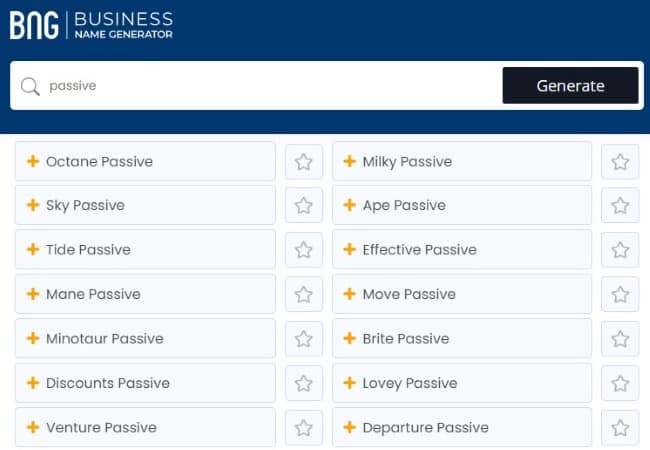
You can also use your own name for your blog. But if you ever plan to sell your website in the future, it is much more difficult to transfer your brand to the buyer when it is your name.
Check Domain Name Availability
After you have brainstormed a few names for your Travel blog, you should check if the .com domain name is available.
Your domain name is your blog’s address on the internet. For example, NomadicMatt.com is the domain name of the blog Nomadic Matt. It’s important to choose a good domain name for your blog as it will be how people find you online.
Check if both the .com domain name and the social media handles are available. You can use Namechk to check the availability of both your domain name and social media handles.

Here are a few things to keep in mind when selecting a domain name:
- Choose a .com domain name. 86% of the internet uses .com, so your visitors are likely to try visiting your blog by typing .com. Avoid other extensions like .net or .org.
- Don’t include hyphens and numbers.
- Do not use words with multiple spellings (for example colour vs color).
- Shorter domain names are better. Try to keep it under 12 characters.
- Spelling & Pronunciation should be easy and intuitive.
- It should be easy to remember.
- Avoid words that can be misread together. For example, therapistjohn.com can be read as Therapist John or The Rapist John.
- Make sure it’s not trademarked or copyrighted by someone else. The AI writing software Jarvis.ai had to rebrand to Jasper.ai because Marvel sued them for the Iron Man reference. Lawsuits will happen once your blog is established.

Register a Domain Name
Once you decide your domain name it is time to register it.
You should register your domain with NameCheap because you will get domain privacy for free. Other providers charge $12 per year for domain privacy. Without domain privacy, your name, home & email address will be accessible to the public.
Step 1: Go to NameCheap. Enter your domain name with the .com extension.

Step 2: Select the .com extension and click the Add to Cart button.
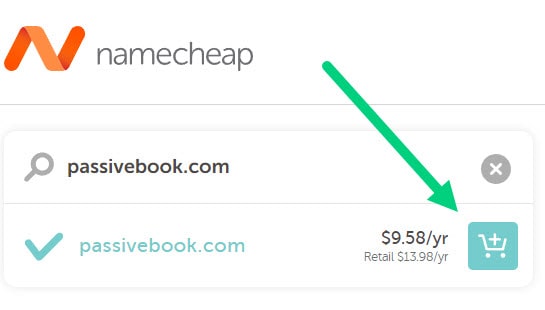
Step 3: After adding the domain to the cart, click on the Checkout button.
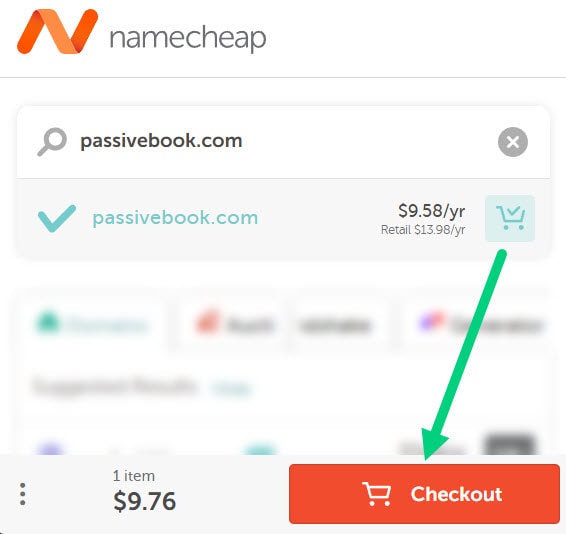
Step 4: Enable Domain Privacy that comes for free along with auto-renew. You don’t need any other paid addon.
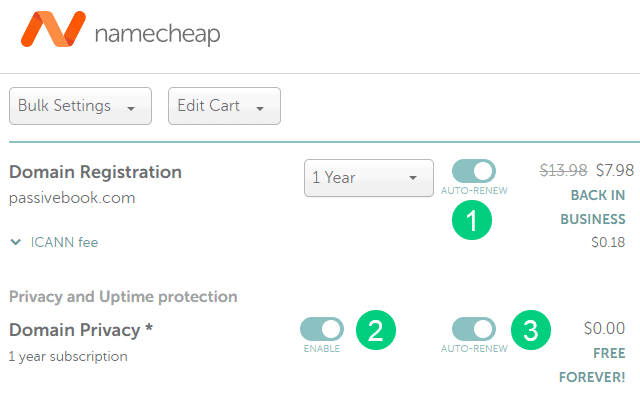
Step 5: Click on Confirm Order. Pay to complete your purchase.
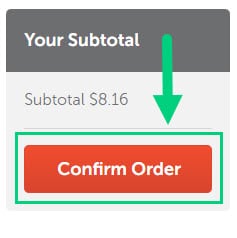
Step 6: Log in to Namecheap and click on Domain List ❶ in the left sidebar and then click Manage ❷ next to the domain you just purchased.
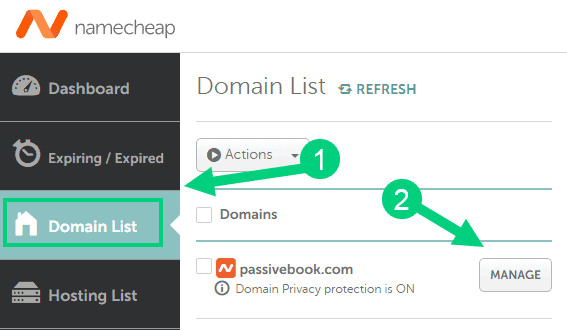
Step 7: Under the Nameservers section, select “Custom DNS” from the dropdown ❶. Then enter the following two nameservers ❷ ns1.bluehost.com and ns2.bluehost.com as shown in the image. Then click the green tick ❸ to save. If you use a hosting provider other than Bluehost, enter their nameserver values in this step instead.
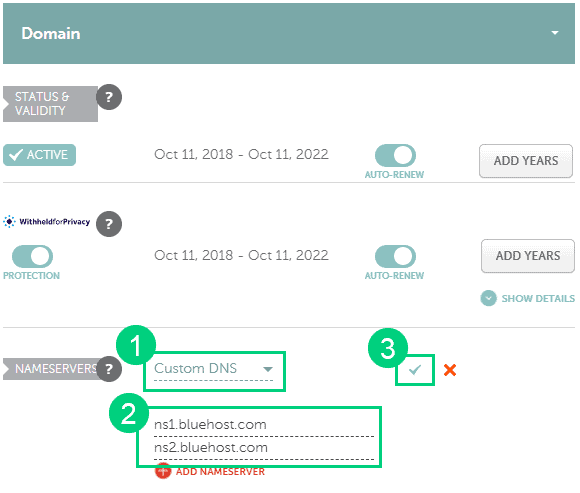
Can I get a free domain name?
Your web hosting provider might give you a free domain name for one year but they charge $12 for domain privacy which is free in Namecheap. From the second year, you will pay for both the domain and privacy which will cost you more than $20+. So it is cheaper to just register your domain with Namecheap from the beginning. Also using different companies for web hosting and domain registration will allow you to easily switch your blog host later without transferring domains.
Can I change the name of my blog later?
You will lose your search engine rankings if you change your blog’s name once it gets links from other websites. It will take as long as a year or more for you to regain the lost traffic. It is possible to mitigate problems by having proper redirects. But you will have to renew both your old and new domains every year. So try to avoid changing your blog’s name once it is established.
4. Setup WordPress
The next step is to get your blog up and running in WordPress. WordPress is a popular blogging platform that is user-friendly and has a lot of features to help you grow your blog. It’s also free to use.
Why Choose WordPress.org?
There are many travel blogging platforms but the self-hosted wordpress.org powers 70% of blogs on the internet. 42% of all websites on the internet use WordPress.
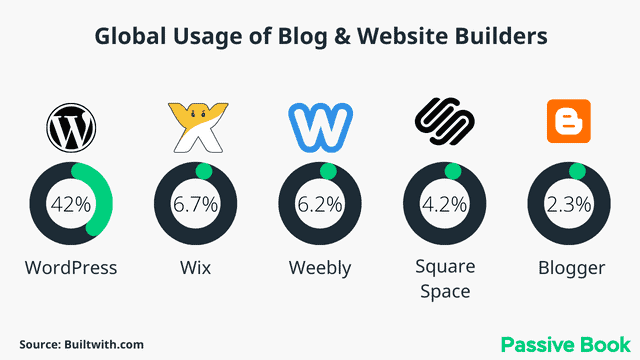
WordPress has a large community of developers who create themes and plugins to add features to your site, it is user-friendly and is optimized to rank in search engines.
WordPress.org vs WordPress.com
There are two versions of WordPress.org and WordPress.com.
We recommend using WordPress.org as it gives you more control over your blog and website. For example, you can install plugins and themes to customize your blog according to your needs.
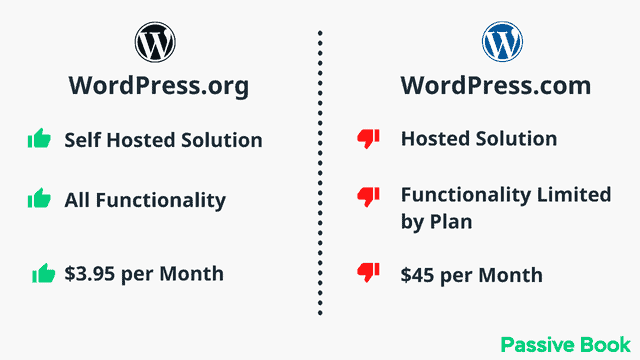
Here are some of the reasons why we recommend using WordPress.org:
- You can use any WordPress theme or plugin of your choice.
- You can make money from your blog with advertising, sponsorships, and affiliate marketing.
- You own your website and content. If you ever want to sell your website, you can do so.
- It is more flexible and scalable as your blog grows.
Why Avoid Free Blogging Platforms
There are many free blogging platforms like Blogger and Medium. While these platforms are easy to use, they have some limitations.
If you build your blog on a free platform, you do not own your content. The platform can shut down your blog at any time without notice.

It is also difficult to make money from a free platform as you do not have control over advertising and other monetization options.
For these reasons, we do not recommend using free blogging platforms
How much does it cost to make a travel blog?
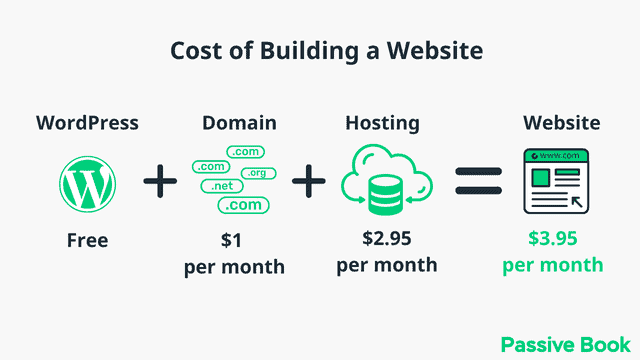
It will cost you $2.95 per month to host your WordPress travel blog in Bluehost. A domain will cost you $12/year. So that is a total of $4.2 per month, which is less than the price of Netflix for all the unlimited features that a self-hosted WordPress blog has to offer.
What to do if you already have a free blog?
If you already have a blog on a free platform like Blogger or WordPress.com, we recommend that you use the built-in export/import tool in WordPress to easily export your content and import it into a self-hosted WordPress blog.
Install WordPress in Hosting
Before you can install WordPress, you need to get web hosting.
Web hosting is the service that stores your blog’s files on a server. This allows your blog to be accessed by people all over the world by typing your domain name in their browser.
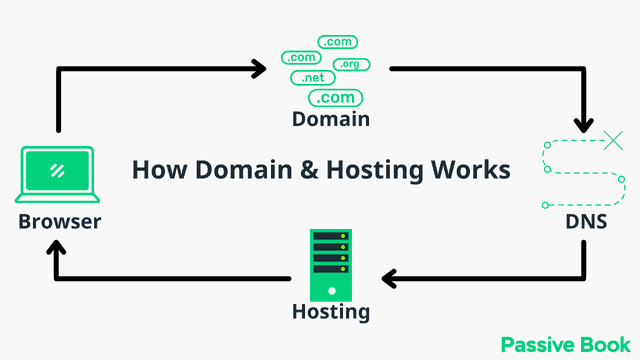
For this guide, we will use BlueHost as our web host. It is a cheap hosting that is extremely easy for beginners to set up. If you use any other web host, the steps will be the same but the user interface may be slightly different.
1. Go to BlueHost using this link to get a special discount. Select WordPress > WordPress Hosting from the top menu.
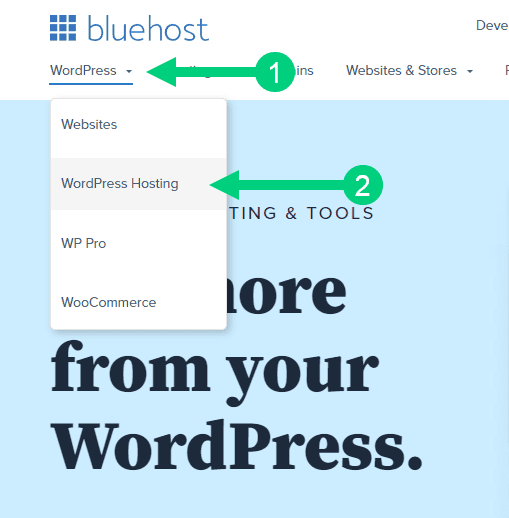
2. Click on the button you see on this page and you will be taken to the pricing section.
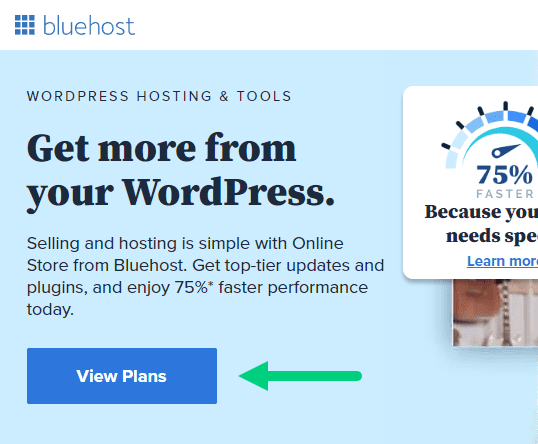
3. Select the Basic Plan. You can upgrade to a different hosting plan as you grow.

4. If you already have a domain name that you purchased with Namecheap you can put that in the “Use a domain you own” ❶ section. If you don’t have a domain name yet, choose the “Create a New Domain” ❷ to purchase a new domain.
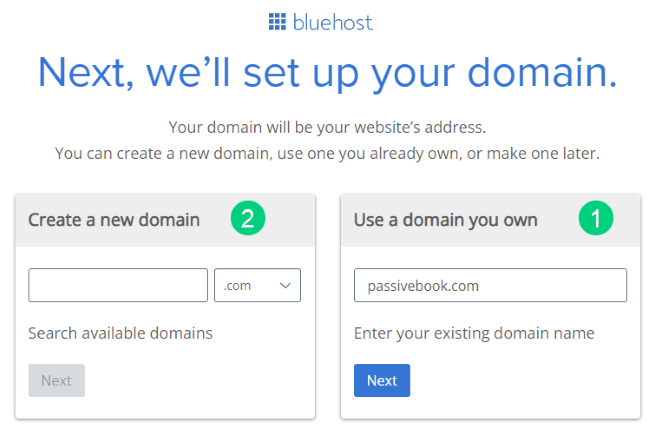
5. In the next screen, enter your information. Uncheck all package extras. If you purchase your domain through Bluehost instead of Namecheap, you may want to enable Domain Privacy. You won’t see the Domain Privacy option if you bought your domain through Namecheap. Namecheap will give you this Domain Privacy for free.
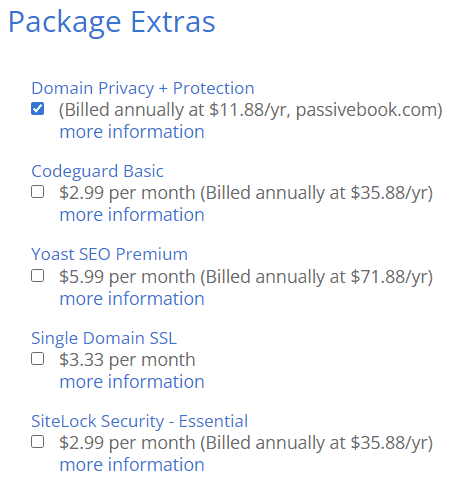
6. Once you have successfully paid, you will be prompted to set a password. Click on the “Create your Password” button.
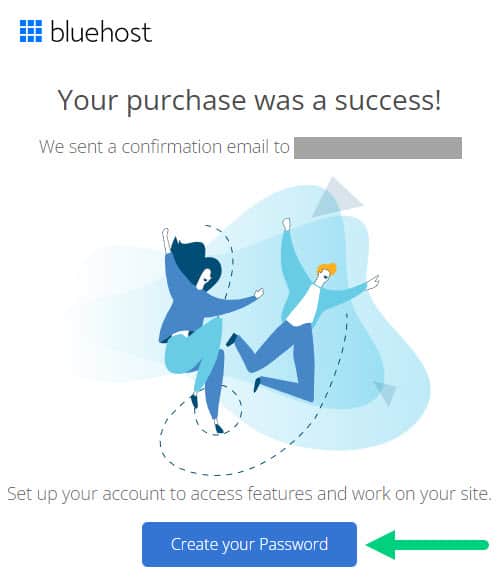
7. Enter your password and create your account. If you lose this password, you can reset it.
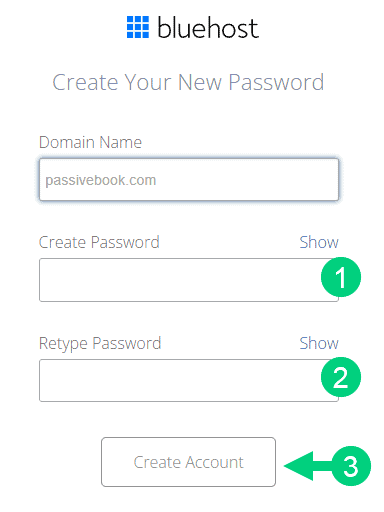
8. After you set your password, log in to Bluehost.
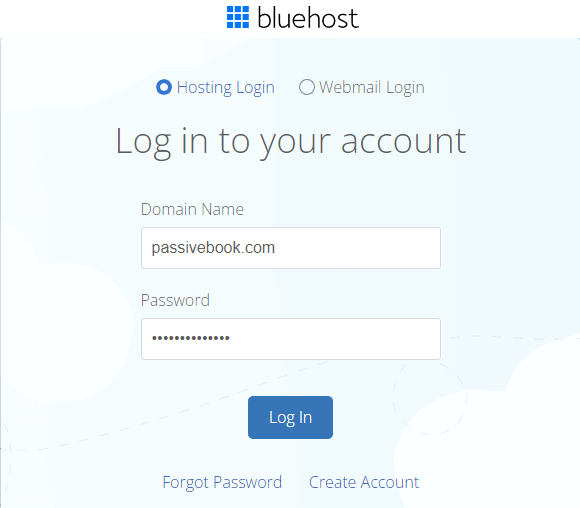
9. Click on the Create your website button on the following screen. This will start a Bluehost Wizard, just click Skip this step wherever possible.

10. On the following page, click “No help needed” or “Skip this step”. We don’t want Bluehost to limit our customization options.
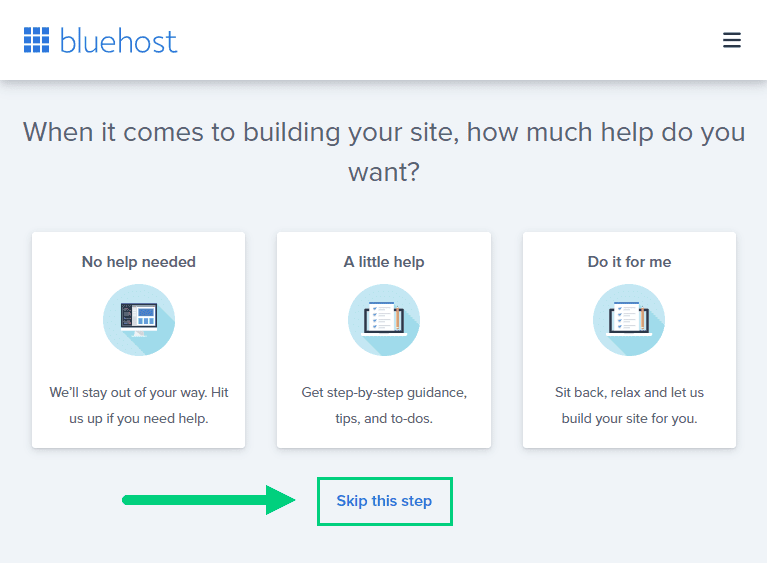
11. On the next page, you will be asked about the purpose of your website. You can choose from any of the available options.
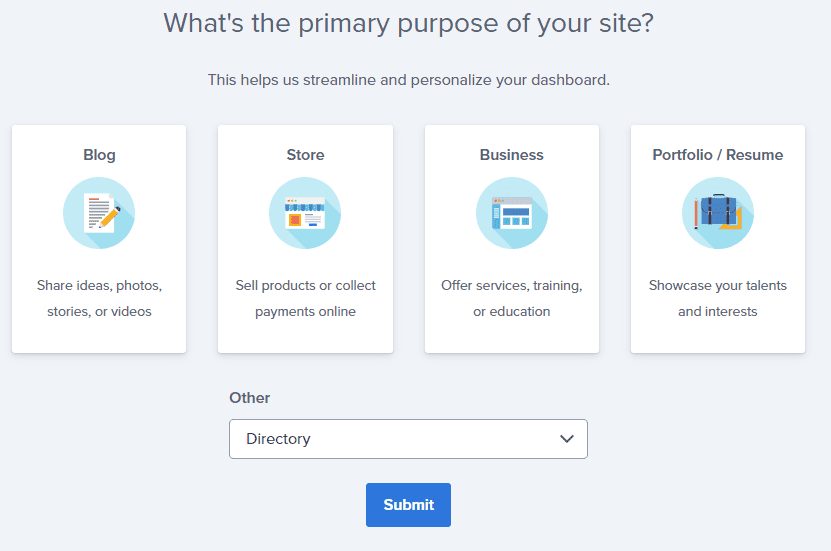
12. On the next page, click Skip this step.

13. On the following page, enter the blog’s name and tagline. You can change this later so feel free to click “Skip this step” or enter something as a placeholder and click Continue.
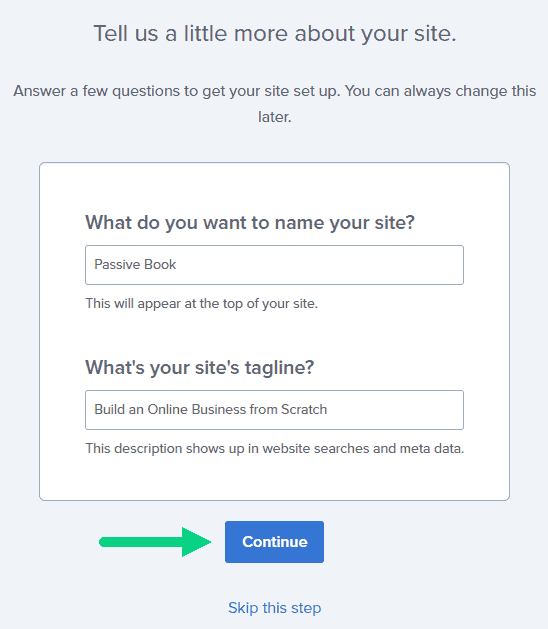
14. Finally you will be asked how you want to build your website. Choose “Limitless customization” to have all the options.

15. You can see your blog by going to yourdomain.com. Go to the Bluehost dashboard and click on the My Sites tab ❶ in the left sidebar and click on the “Manage site” button ❷.
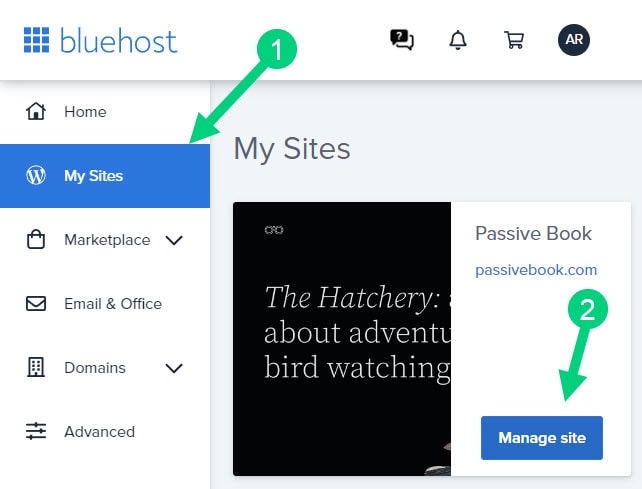
16. Your WordPress site has separate login credentials different from the ones you use to log into Bluehost. You can use this to log in to the WordPress dashboard directly without logging into Bluehost. To get this:
❶ Click on Users on top.
❷ You will be able to see your username and email that you can use to log in to WordPress.
❸ If you click on the three dots you will see the option to Reset your password. ❹
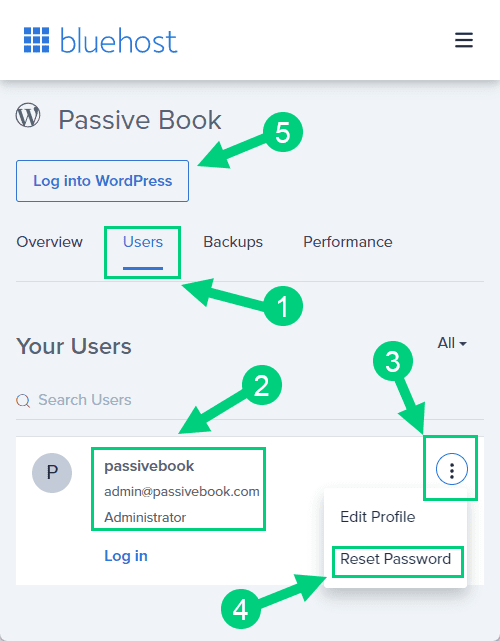
You can log into WordPress from the Bluehost dashboard by clicking the Log in to WordPress button ❺. But it is not recommended you rely on this as your primary login method because you will get locked out of your site if you ever change hosting providers.
17. You will be taken to the WordPress dashboard where you can reset your password ❶. If you don’t like the username Bluehost created for you, you can Add a New User ❷.

18. If you are adding a new user make sure you specify the user role as Administrator ❶. You can log in as the new user and safely delete the default user created by Bluehost.

Congratulations! You have successfully set up WordPress.
Configure WordPress
Now that you have the basic version of WordPress installed, it is time to customize it to make it look and feel the way you want.
Login to WordPress Dashboard
Visit yourdomain.com/wp-admin to access the WordPress dashboard.
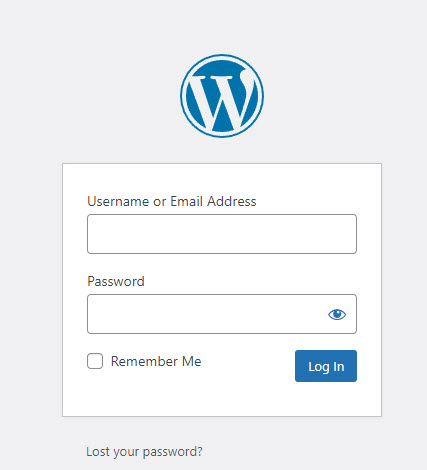
The WordPress dashboard is the control center for your WordPress site. It provides a lot of options and features to help you manage and grow your blog.
From the dashboard, you can:
- Add new posts and pages
- Edit posts and pages
- Manage comments
- View site stats
- Add users to your blog
Use the Email and Password you provided during installation to log in to your WordPress dashboard. If you don’t have a password, use the “Lost your password?” to generate a new password.
Install WP Themes
A WordPress Theme is a collection of files that controls the design and layout of your WordPress site.
When you install WordPress, you are given a default theme. However, you can install any free theme of your choice from the WordPress Theme Directory or from other sources.
To install a new WordPress Theme:
Go to Appearance > Themes > Add New in your WordPress dashboard.
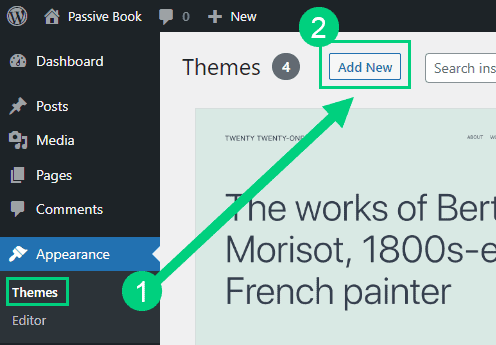
Use the search to find a theme that you like ❶. Before you install the theme, you can see a demo of the theme and learn about its features from the preview screen ❷. If you like the theme, you can install it by clicking the install button ❸. You can also upload a theme from a file on your computer ❹.

Once installed, click the Activate button to enable the theme.
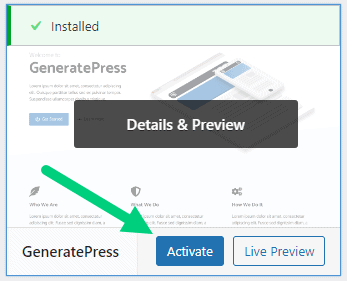
There are thousands of WordPress themes to choose from and they come in different categories like magazine, business, eCommerce, etc.
We recommend that you purchase and install a premium theme because it has a lot of customization options and your website will load fast. The premium themes we recommend are:
There are also several themes custom-made for Travel blogs. These themes tend to be bloated with poor code which will slow down the performance of your website. We suggest getting one of our recommended themes for a fast website with unlimited customization possibilities.
Install WP Plugins
A WordPress Plugin adds features and functionality to WordPress. There are thousands of WordPress plugins to choose from and they come in different categories like security, SEO, social media, etc.
Too many wordpress plugins can slow down your blog site. So before you install new plugins, it will be worth clearing out any existing plugins that your hosting provider installed by default.
Plugins first need to be deactivated before they can be deleted.
❶ Go to WP Admin > Plugins > Installed Plugins
❷ Click on the checkbox to select all plugins.
❸ Select Deactivate from the drop-down.
❹ Click Apply.
❺ Repeat the above steps but select “Delete” instead of “Deactivate” from the dropdown in ❸ to delete all the deactivated plugins.
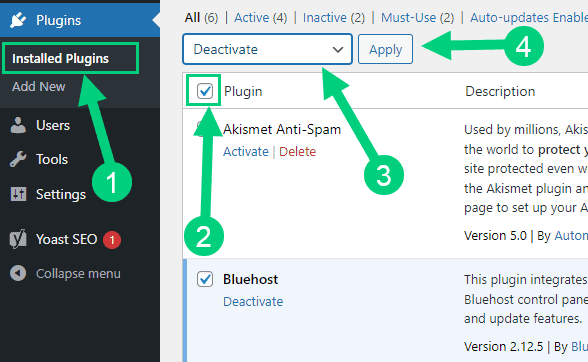
To install new plugins go to the WP Admin > Plugins > Add New.

On the plugins page:
❶ Search for the plugin you want in the search bar
❷ Click Install Now. Once you install the plugin, you must also activate the plugin for it to be enabled.
❸ If you are installing a paid plugin you can upload the plugin instead.
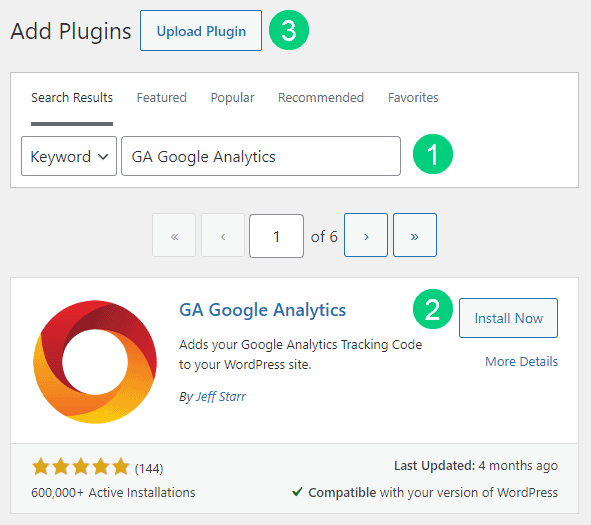
There are many different plugins that you can install, but here are the ones which we recommend:
Maps Plugins: If you are planning to write Travel articles that focus on a certain location, then you will need to install a maps plugin. This will help your readers visualize the places you are talking about in your articles.
Recommended Plugin: WP Google Maps (free)
Backup Plugin: A WordPress Backup Plugin is a plugin that helps you create backups of your WordPress site so you can restore it if something goes wrong.
Recommended Plugin: WPVivid (paid) or UpdraftPlus (free).
SEO Plugin: A SEO plugin helps you optimize your travel blog for search engines. It helps you add metadata, titles, and descriptions to your posts and pages. It also helps you optimize your website for keywords, social media, and more.
Recommended Plugin: RankMath (paid).
Google Analytics Plugin: WordPress Analytics Plugins help you track your website traffic and measure the performance of your blog posts.
Recommended Plugin: RankMath (paid) or GA Google Analytics (free).
Cache Plugin: A WordPress Cache Plugin speeds up your website by caching your website’s static files. This means that your website will load faster for your visitors.
Recommended Plugin: WP Rocket (paid).
Page Builder Plugin: A WordPress Page Builder Plugin allows you to create custom pages and posts with drag and drop features. This means that you don’t need any coding knowledge to create custom pages and posts.
Recommended Plugin: Thrive Architect (paid).
Security Plugin: A WordPress Security Plugin is a plugin that helps you secure your WordPress site from hackers and malware. It helps you add security features like two-factor authentication, firewall, and malware scanning.
Recommended Plugin: Wordfence (free).
Social Media Plugin: A WordPress Social Share Plugin allows you to share your blog posts on social media networks like Facebook, Twitter, and LinkedIn.
Recommended Plugin: Easy Social Share Buttons (paid).
Customize WordPress
Once you have installed your theme and plugins, it is time to customize the wordpress blog platform:
Change Colors, Fonts & Spacing
You can set the font, colors, and spacing by going to Appearance > Customize in your WordPress dashboard. Premium themes like GeneratePress allow you to customize every aspect of your blog.
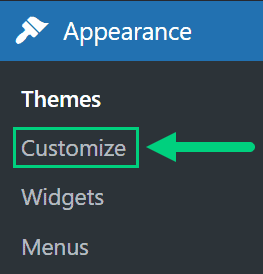
Check out our Blog Fonts & Typography guide to choose the right font and typography settings for your blog.
Add Your Logo
Get a logo designed for your blog from Fiverr. Then set the logo of your blog by going to Appearance > Customize in your WordPress dashboard. A logo is not required for a successful blog but it can definitely help appeal to your target audience.
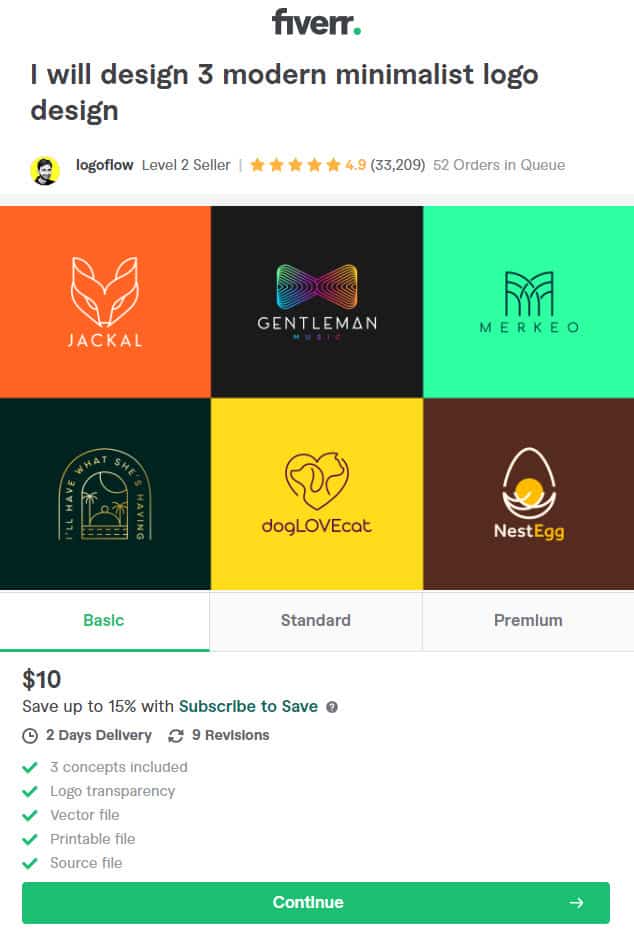
Change Favicon
Favicon is the image that appears in the browser tab and bookmarks. Set the Favicon from the Appearance > Customize section of the WordPress dashboard.

Create Menus
The header and the footer menu can be set from the Appearance > Menus in your WordPress blog dashboard.

You can nest menu items so that it appears as a dropdown menu ❶. You can use the menu as your primary or secondary navigation menu ❷. Don’t forget to save your menu ❸.
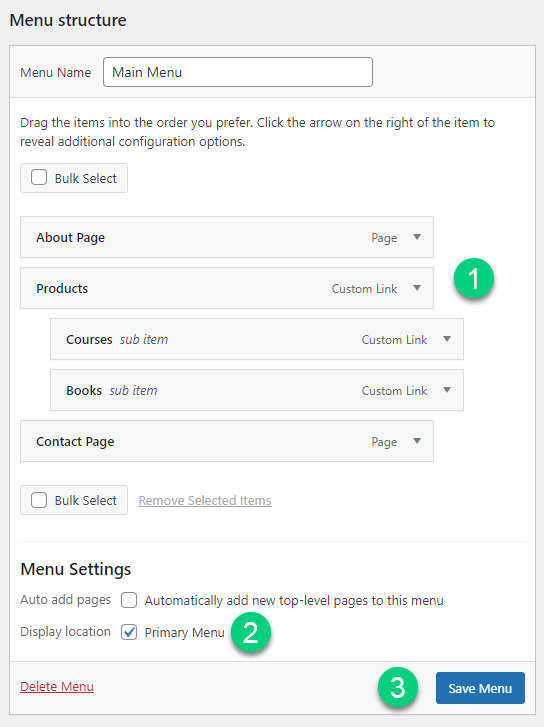
Create Widgets
If you have a sidebar, you can add widgets to it. Go to Appearance > Widgets in your WordPress admin dashboard.
Check out the list of the most useful Blog Widgets and how to add them to your blog.

Set Title & Tag Line
The next step is to change your General Settings. Go to Settings > General in the WordPress Admin area.
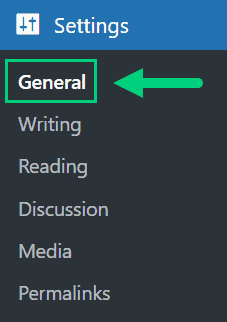
You can set your Site Title, Tagline, and Time Zone from this screen.
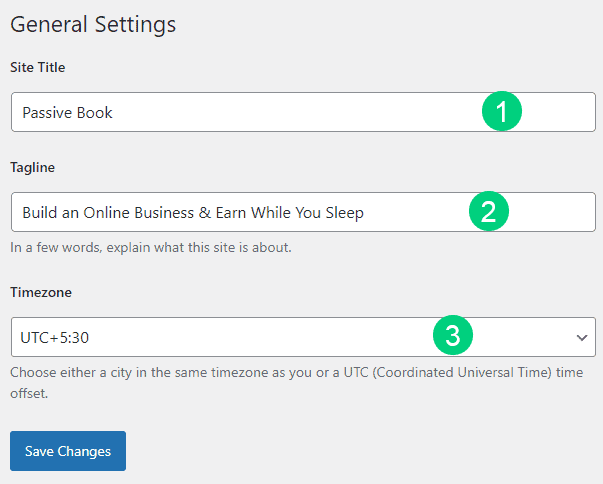
Set Permalinks
The ideal URL structure for SEO is yourdomain.com/sample-post. Set your permalink structure by going to Settings > Permalinks in your WordPress blog dashboard.

Select the “Post name” radio button and save changes.
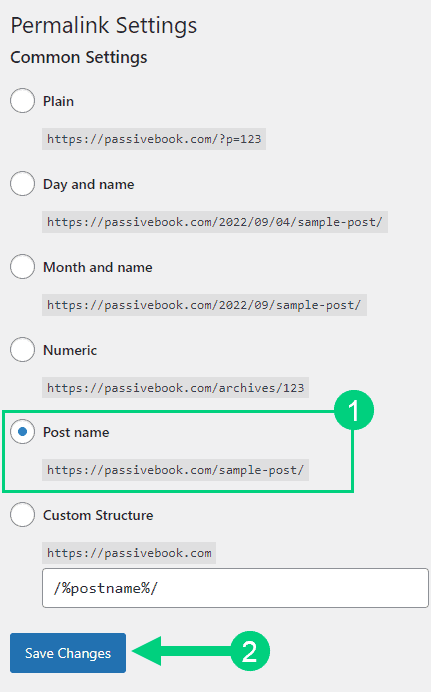
Enable Search Visibility
Chances are you want your blog to show up on Google so people can find you. Go to Settings > Reading in your WordPress dashboard.
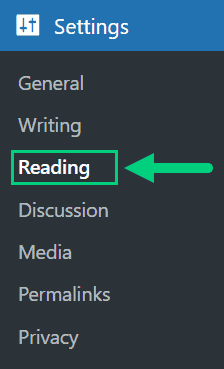
To get search engine traffic, ensure the checkbox “Disable search engines from indexing this site” is Unchecked. You can find this option in Settings > Reading. Most of the time this should be unchecked by default but if it is not, then uncheck it to ensure your site gets traffic from search engines.
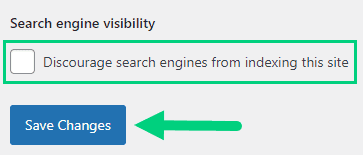
Adjust Comment Settings
Next, you will want to change the Discussion Setting (aka Comments). Go to Settings > Discussion in your WordPress admin area.
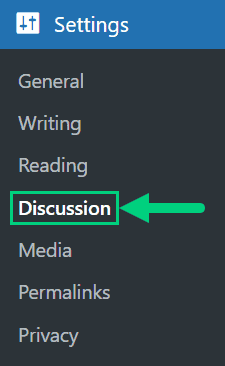
❶ You may want to enable or disable comments on this page. You can also disable pingbacks and enable comment moderation.
❷ You can also set comment approval settings.
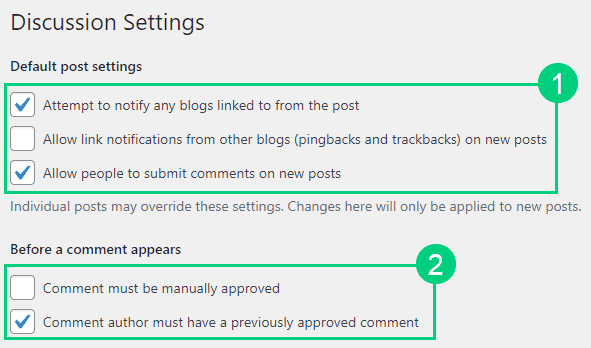
If you want to design your blog further, check out our dedicated guide on blog design which has all our best blog design recommendations.
Create Static Pages
There are a few essential pages that you need to create for your Travel blog before you can start blogging.
Use pages in WordPress to add static content. Go to WP Dashboard > Pages > Add New.
- Write the headline of your content.
- Populate the body content
- Click the publish button.

You may want to create the following pages:
Home Page
A home page is the first page that a visitor sees when they visit your website. It is usually a page that has your blog’s latest posts and a slideshow or featured image.
When creating your home page, you will want to include the following:
- A slideshow or featured image
- Latest posts from your blog
- Links to your social media profiles
- A contact form or email address
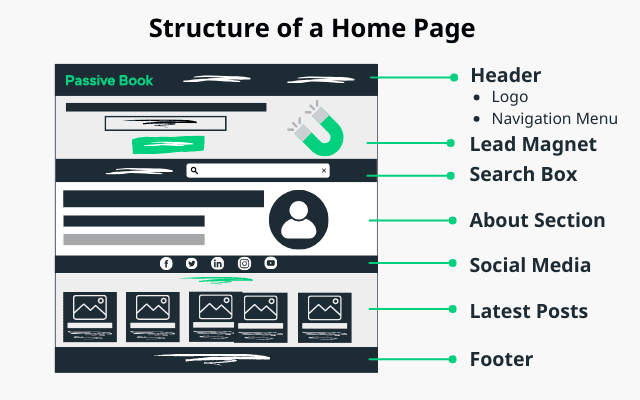
You can create a professional home page for your Travel blog using a page builder like Thrive Architect.
About Page
An about page is a page where you tell your visitors who you are and what your blog is about.
When creating your About page, you will want to include the following:
- A brief description of who you are
- What your Travel blog is about
- Links to your social media profiles
- A contact form

Contact Page
A contact page is a page where you give your visitors a way to contact you.
When creating your contact page, you will want to include the following:
- A contact form
- An email address
- A mailing address (if you have one)
- Links to your social media profiles
Use contact form plugins like Fluent Forms to create the form on your contact page.
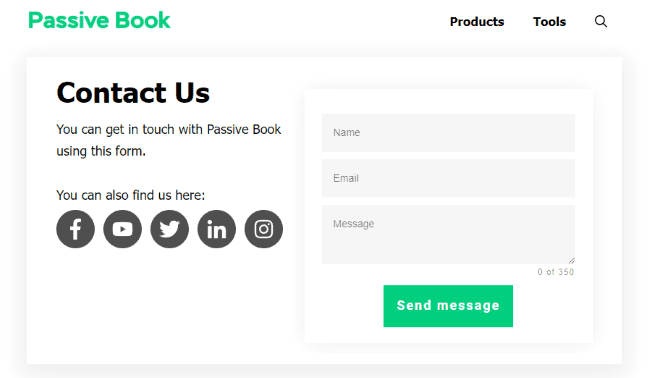
Privacy Policy
A privacy policy page is a page where you tell your visitors how you use their personal data.
When creating your privacy policy page, you will want to include the following:
- What personal data do you collect
- How you use personal data
- How you protect personal data
- How long do you keep personal data
WordPress generates its own privacy policy for you. But you can also use a tool like Termly to generate your own privacy policy.

Terms of Service
A terms of service page is a page where you tell your visitors the rules that they need to follow when using your website.
When creating your terms of service page, you will want to include the following:
- What users can and cannot do on your website
- How you will handle disputes
- How you will handle changes
Use a terms & conditions generator like Termly to create it.
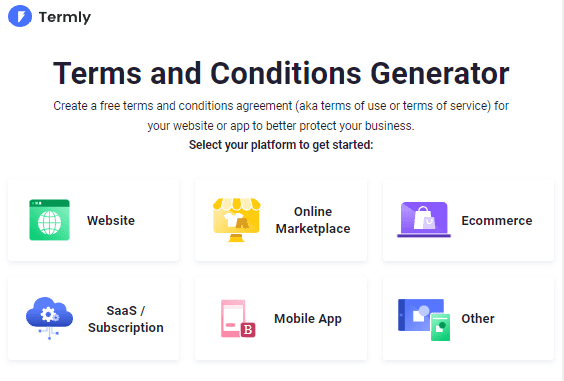
5. Write & Publish Blog Posts
Now that you have your Travel blog set up, it’s time to write and publish your first blog post.
1. Brainstorm Topics
First start by brainstorming 100 topic ideas for your travel blog. This will ensure that you always have content to write about in your Travel blog.
The goal is to find topics for your Travel blog that your audience is searching for in Google. The type of content you write on your Travel blog will depend on your specific niche. You can potentially cover the following topics on your Travel blog:
- Travel Guides
- Travel Tips
- Travel Products
- Travel Destinations
- Reviews
- Packing Lists
- Places to Visit
- Saving Money
- Mistakes to Avoid
There are a few ways to brainstorm specific content:
Look at Competitors
When brainstorming topics for your Travel blog, it’s a good idea to look at your competitor’s websites. By doing this, you can get an idea of the type of content that is popular in your niche. You can also come up with ideas for your own content by looking at the topics that your competitors are writing about.
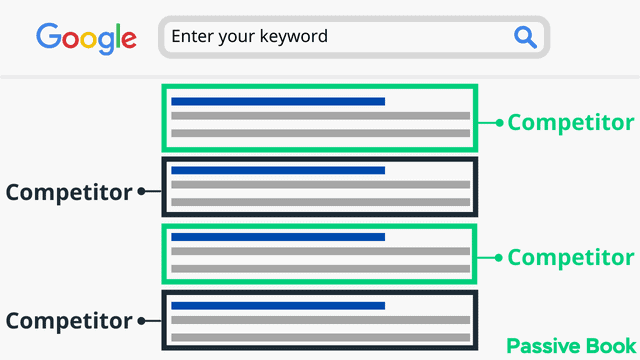
Do Keyword Research
When you are brainstorming topics for your Travel blog, it’s important to do keyword research. You want to make sure that you are writing about topics that people are actually searching for on Google.
There are a few tools that you can use to do keyword research:
Plugin your keyword into the keyword research tool to get other relevant keywords on the topic.
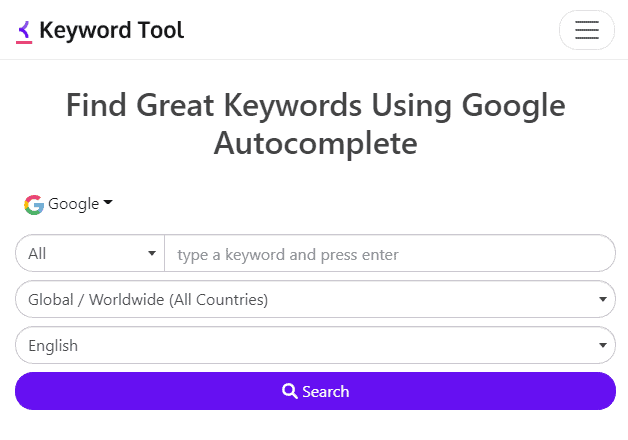
Community & Forums
Look at questions being asked in community and travel forums. You can use sites like Reddit, Quora, and Facebook Groups to find questions being asked in your niche.
2. Create an Editorial Calendar
Once you have a list of topics to write about, it’s time to create an editorial calendar. This will help you to plan and organize your content.
An editorial calendar is simply a document that contains all of the blog posts that you plan to write and publish.
You can include the keyword you are targeting, the title of your blog post, the date you plan to publish it, and a brief description.
You can create your editorial calendar in Google Sheets, Notion, or Trello.
Download Content Calendar Template

Steal our exclusive content calendar template. Have it delivered directly to your inbox:
3. Write & Publish Your Blog Post
Now that you have a bunch of topics to write about, it’s time to actually write and publish your blog post. We have an in-depth guide on How to Write A Blog Post. Here we will go over specific tips for a travel blog.
Write 5x Faster With AI
You can write your new blog post at 5x speed using the AI writing software Jasper. I was able to write over a hundred blog articles in 3 months using Jasper. This blog article you are reading right now was written with the help of Jasper. AI will not only help you write blog posts fast but also with higher quality.
Jasper can write plagiarism-free blog content, articles, social media content, emails, and ad copy. All you have to do is provide a few inputs on what you want and Jasper will do all the hard work of creating the blog content for you. No more writer’s block.
Check out the video below to see Jasper in action:
Try Jasper for free using the links on this page and get 10,000 bonus credits you can use to start writing your first articles.
Once you sign up for Jasper I recommend you spend some time going through the tutorial videos in the Jasper Bootcamp to truly unlock the power of this amazing software.
Check out our guide on How to Write a Blog Post Fast in 15 mins Without Losing Quality for more tips to write fast.
Writing Travel Guides
Travel guides are posts that provide detailed information and tips for planning a trip to a specific destination. This can include information on visas, transportation, and accommodation, as well as recommendations for things to see and do.
Here are examples:
- “How to Plan the Perfect Trip to [Destination]”
- “The Essential Guide to [Destination]: What You Need to Know”
- “Your Ultimate [Destination] Itinerary: How to Make the Most of Your Trip.”
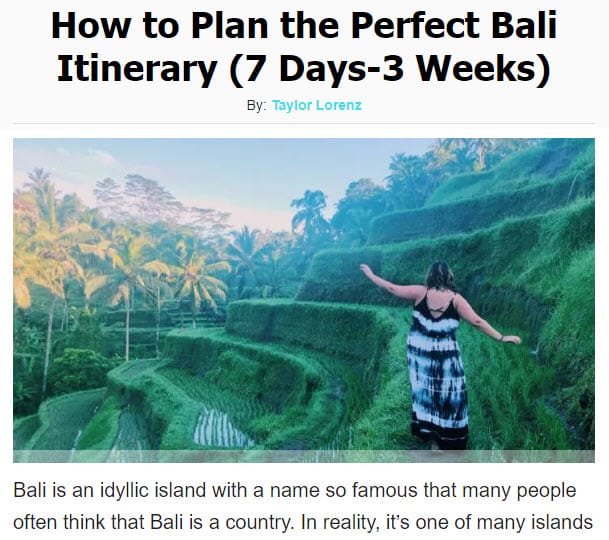
When writing a travel guide, you will want to include the following:
- The destination of the travel guide
- How to get there
- What to do when you arrive
- Accommodation
- Food and drink
- Things to see and do
- How much it will cost
Writing Travel Reviews
Another popular type of content in the travel niche is a Travel Review. A Travel Review is simply a blog post where you review a specific product or service related to travel. This is usually travel gear that will help you earn an affiliate commission.
This could also be anything from a hotel to a tour company to a piece of luggage.
Here are a few examples:
- The Best Carry-On Luggage for Every Type of Traveler: A Review
- The Best Travel Pillows for Comfort on the Go: A Review
- A Review of the Best Travel Adaptors for Global Adventures
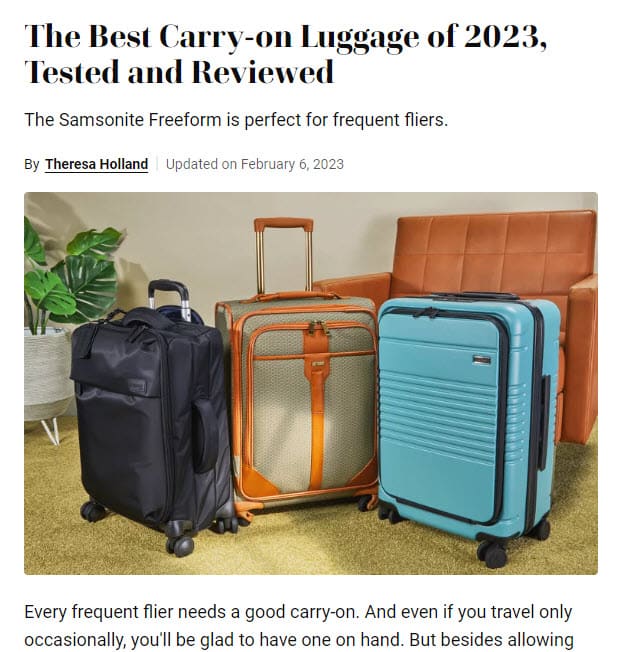
When writing a travel review, you will want to include the following:
- The name of the product or service you are reviewing
- A brief description of the product or service
- Your personal experience with the product or service
- The pros and cons of the product or service
- Who the product or service is best for
- Your overall rating of the product or service
Destination Reviews
Destination reviews are posts in which you share your experiences and tips for visiting a specific location. This can include information on the best things to see and do, as well as recommendations for where to eat and stay.
Here are a few examples:
- Discovering the Hidden Gems of Paris: A Personal Travel Review
- Exploring the Beauty of Santorini: My Experience and Tips
- Rome, Florence, and Venice: A Review of Italy’s Most Iconic Cities.
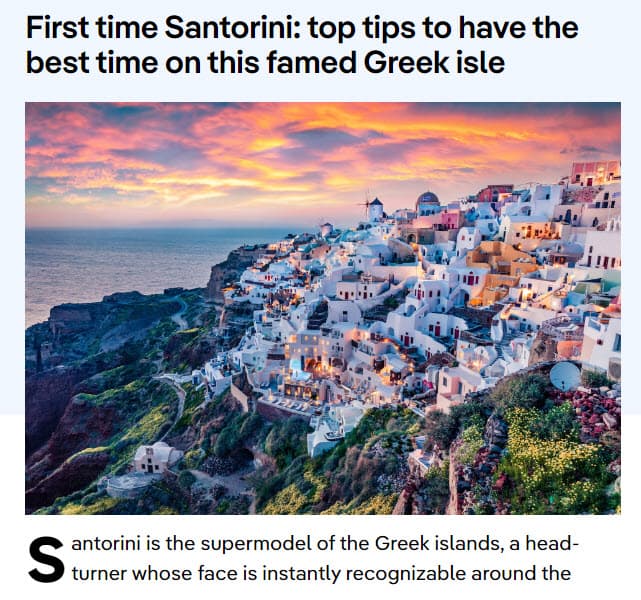
When writing a destination review, it’s important to be specific and provide detailed information. Be sure to include information on how to get to the destination, what the best time of year to visit is, and what types of activities and experiences are available. Additionally, it’s helpful to include photos and personal anecdotes to give readers a sense of what it’s like to actually be at the destination.
Writing Travel Tips
Travel Tips are another popular type of content in the travel niche. These are blog posts that provide your audience with tips and advice on how to travel better. These types of posts can include information on how to pack, how to stay safe, or how to find the best deals on flights and accommodations.
You can either write a list post with a bunch of travel tips or a how-to post that dives in deep and takes the reader step by step.
Some examples of travel tips you could write about include:
- How to save money while traveling
- How to pack for a trip
- How to stay safe while traveling
- How to find the best deals on flights and hotels
- How to avoid jet lag
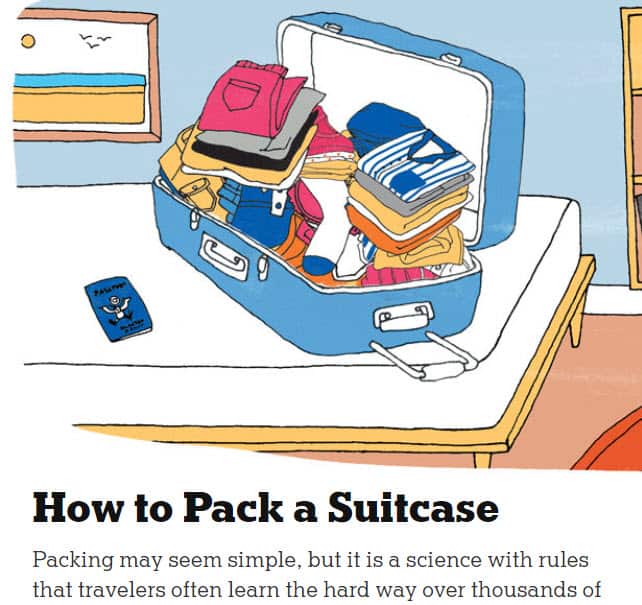
It’s important to be specific and provide actionable advice. Provide detailed information on how to do things, such as how to pack for a long trip, what to do if something goes wrong, or how to find the best deals on flights.
Personal Stories
Personal travel stories are posts that share your personal experiences and reflections on your travels. These types of posts can include information on the challenges you faced and the lessons you learned.
Here are a few examples:
- “My Journey to [Destination]: A Personal Story”
- “Lessons Learned on the Road: My Time in [Destination]”
- “Overcoming Challenges: My Experience in [Destination]”
- “How I Started My Travel Blog”
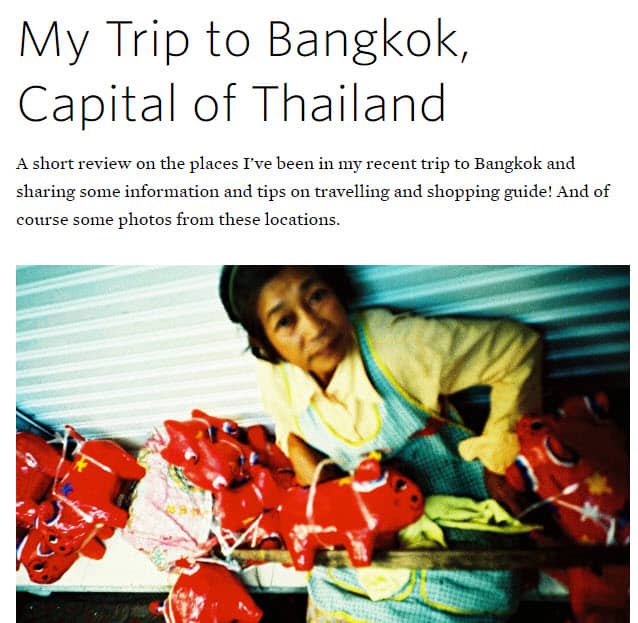
When writing a personal story, it’s important, to be honest and authentic. Share your experiences, both good and bad, and provide readers with a sense of what it was like to be in your shoes. Additionally, it’s helpful to include lessons learned or advice for others who may be considering a similar trip.
Travel News & Trends
Travel news and trends are posts that share the latest news and trends in the travel industry. These types of posts can include information on new destinations, travel technologies, or sustainable travel practices.
Here are a few examples:
- “The Top Destinations for 2024“
- “New Travel Technologies You Need to Know About”
- “The Future of Sustainable Travel.”
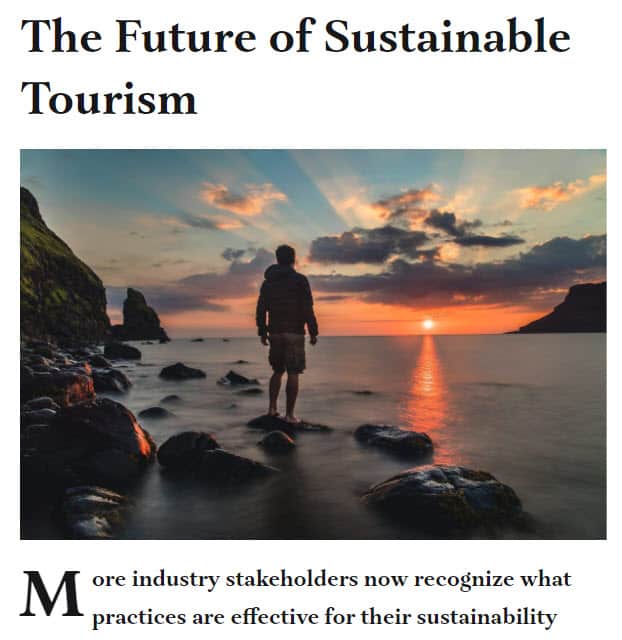
When writing about travel news and trends, it’s important to be up-to-date and provide accurate information. Research the latest developments in the travel industry and provide readers with a sense of what to expect in the near future. Additionally, it’s helpful to include your own opinion or analysis on the topic to give readers a unique perspective.
Food & Drink
Food and drink posts are posts that share your food experiences and reviews on restaurants, street foods, and drinks from your travel. These types of posts can include information on the specialties of the destinations, the best places to eat and drink, and any unique experiences you had.
Here are a few examples:
- “Exploring the street food scene in [Destination]”
- “Top restaurants for a romantic dinner in [Destination]”
- “Best bars for a night out in [Destination]”
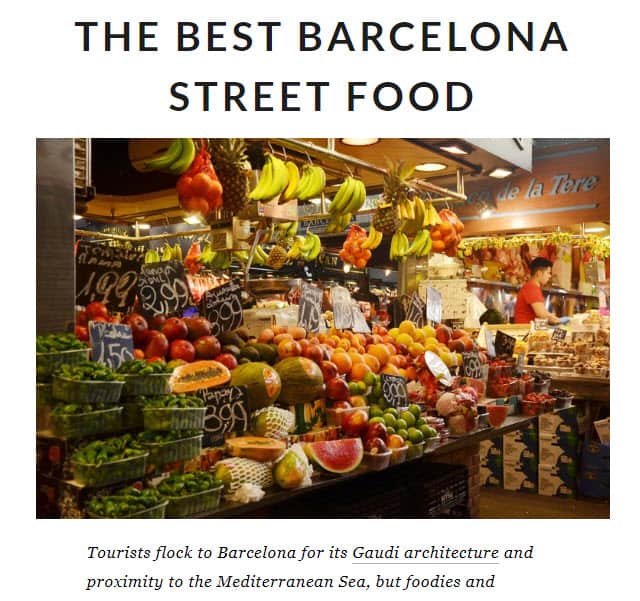
When writing about food and drink, it’s important to be specific and provide detailed information. Include information on the type of cuisine, the atmosphere of the restaurant, and the prices. Additionally, it’s helpful to include photos of the dishes and drinks, to give readers a sense of what they can expect.
Adventure & Activities
Adventure and activities posts are posts that share your experience of adventure activities and sports you did during your travel. These types of posts can include information on the best places to go for adventure, the types of activities available, and any unique experiences you had.
Here are a few examples:
- “The best places for adventure sports in [Destination]”
- “Hiking in [Destination]: The best trails for all levels”
- “Exploring the wilderness: My experience in [Destination].”
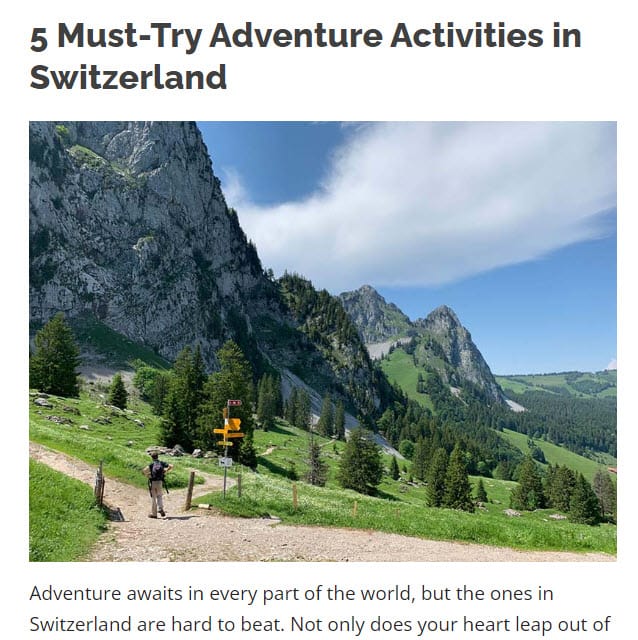
Include information about the activity, the difficulty level, and the cost.
Photo Journals
Photo journals are posts that share a collection of photos from your travels, along with captions and a brief description of your experiences. These posts are a great way to share your experiences with others and give them a sense of what it’s like to be in a particular destination.
Here are a few examples:
- “A Photographic Journey Through [Destination]”
- “Snapshots of [Destination]: A Photo Essay”
- “Through the Lens: My Favorite Photos from [Destination].”

When writing a photo journal, it’s important to choose high-quality photos that accurately represent your experiences. Be sure to include captions that provide context and background information for each photo. Additionally, it’s helpful to include a brief introduction or summary at the beginning of the post to give readers an overall sense of what the post will be about.
General Writing Tips
Here are a few tips for writing and publishing your blog post:
- Write in a clear, concise and easy to read manner
- Use short paragraphs and sentences
- Use subheadings to break up your content
- Use images, infographics and videos to break up your content
- Add external links to authority sites
- Include a call to action at the end of your blog post
When you are ready to publish your blog post, simply log in to your WordPress dashboard and click on “Add New” under the “Posts” section.
Enter a title for your blog post ❶ and then start writing your content in the editor ❷.
Once you are finished, click on the “Publish” button ❸ to make your blog post live on your website.

Hire A Writer
If you don’t want to write the blog post yourself or use AI writing software, you can always hire a writer. There are several different places you can find writers, such as Fiverr & Upwork.

4. Add Images & Travel Photos
If you are doing a lot of traveling yourself then it is worth investing a bit in DSLR cameras to capture high-quality images of your travel. I would recommend Canon EOS Rebel T6 Digital SLR Camera with EF-S 18-55mm f/3.5-5.6 IS II Lens as it’s a great entry-level DSLR camera.
When taking photos, try to capture a mix of landscape shots, close-ups, and people shots. And if you are traveling with someone, make sure to get some photos of you both together.
If you are not a professional photographer, then don’t worry, you can still get some great shots with a basic point-and-shoot camera or even your smartphone.
There are also several stock image sites where you can purchase high-quality travel images to use on your blog posts. Some of the most popular stock image sites are:
Free Options: Pixabay, Pexels, Upsplash
Paid Options: Deposit Photos, Shutterstock, iStock, Getty Images, 123rf.
You can edit your images in Canva. If you get Canva Pro, you can also access a large library of high-quality photos that you can use on your travel blog.
6. Promote Your Travel Blog
Now that you have published a few blog posts, it’s time to start promoting your travel blog.
Search Engine Optimization (SEO)
One of the best ways to get organic traffic to your travel blog is to optimize your blog posts for search engines.
There are several different ways you can optimize your blog posts for SEO:
- Use keywords throughout your blog post
- Optimize your images with keywords
- Link to other relevant articles on your website
Many factors go into SEO, and it can be a bit confusing to figure out where to start. You can master the more advanced SEO tactics by checking out our SEO Resources.
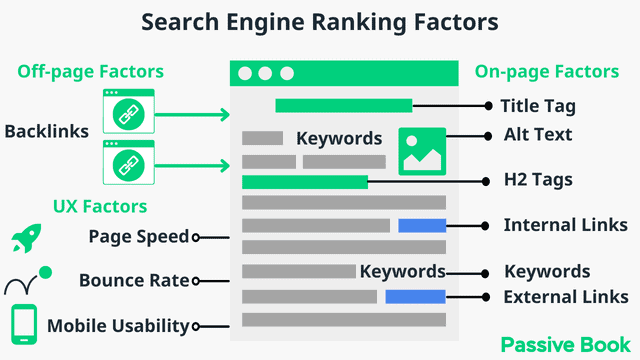
You can ensure you get the basics of SEO right, by completing the recommendations given by the RankMath plugin.
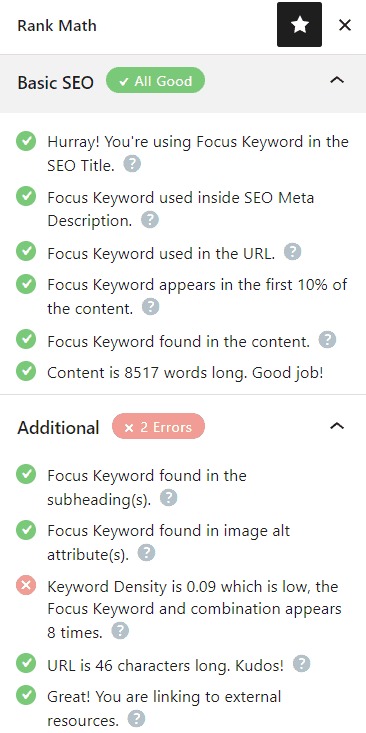
Email Marketing
Another great way to promote your travel blog is through email marketing.
Email marketing allows you to build a list of subscribers who have permitted you to contact them with updates from your website.
You can then use this list to send out periodic emails with links to your latest blog posts.
This is a great way to keep your subscribers updated on your latest content and drive traffic back to your website.
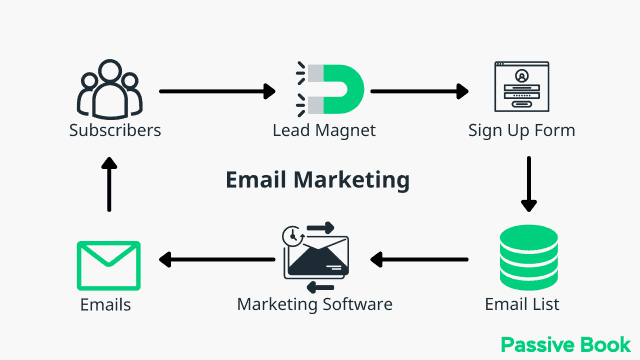
You can use the Thrive Leads plugin to build opt-in forms to collect email addresses. You can then connect the opt-in form to an email marketing service like Active Campaign to send out the emails.
Check out our Email Marketing resources to learn more.
Social Media Marketing
Share each new blog post on social media sites like Facebook, Twitter, Instagram, and Pinterest. You can also join relevant Facebook groups and forums and share your blog post with these communities.
Guest blogging
Guest blogging is when you write a blog post for another website in your niche.
This is a great way to get exposure for your travel blog and to build relationships with other bloggers in your niche.
It’s also a great way to drive traffic back to your website if you include a link back to your website in your guest blog post. You can use your author bio to promote your blog.

7. Monetize & Make Money
After you start getting a steady stream of traffic coming to your travel blog, it’s time to start monetizing your website.
There are many different ways you can make money from your travel blog, such as:
Advertising
One of the most common ways to make money from a blog is to use advertising.
This is where you allow other businesses to place ads on your website in exchange for a fee.
The amount you can charge for advertising will depend on the amount of traffic you are getting to your website and the size of your ad space.
To start advertising on your blog, you can sign up for an ad network like Ezoic (they pay more than Google Adsense). When your blog starts getting more than 100,000 page views a month you can monetize with Adthrive.
| Ad Network | Earnings Per 1K Impressions (EPM) | Monthly Traffic Requirement |
|---|---|---|
| Ad Thrive | $13 | 100,000 |
| Ezoic | $3 | 10,000 |
| Media.net | $1 | – |
| Google Adsense | $1 | – |
Sell Products
Another great way to make money from your travel blog is to sell products.
This could be anything from e-books and online courses to physical products like clothes, jewelry, and souvenirs.
If you are selling physical products, you will need to set up an online store and arrange for shipping.
You can use Teachable if you want to sell video courses. Your students will have a dedicated course members area and a community system to ask questions and interact with each other. If you only want to sell eBooks, you can use SendOwl which lets you sell your digital products and eBooks for free.

Affiliate Marketing
Affiliate marketing is when you promote other people’s products or services on your website and earn a commission for each sale that you generate.
This is a great way to monetize your website if you are promoting products that are relevant to your niche.
For example, if you are a travel blogger, you could promote travel products like luggage, travel insurance, and hotels on your website.
If someone clicks on one of your affiliate links and makes a purchase, you will earn a commission.
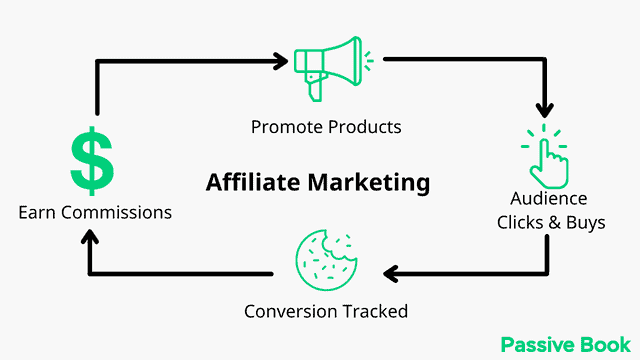
You can find affiliate programs to join by searching for “affiliate program” + your niche. For example, if you are in the travel niche, you could search for “travel affiliate programs.”
There are also several affiliate networks that you can join, such as ShareASale and Awin.
Sell Services
If you have a skill or service that you can offer, you can sell it through your travel blog.
For example, if you are a good photographer, you could sell your services as a travel photographer.
Or if you are a web designer, you could sell your services as a web designer specializing in travel websites.
You can sell your services directly through your website or a freelancing platform like Fiverr or Upwork.

Sponsored Posts
A sponsored post is when a brand pays you to write a blog post about their product or service.
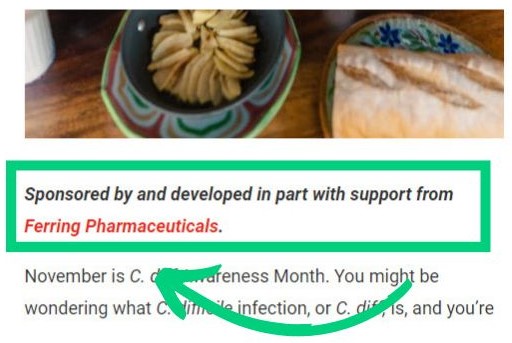
This is a great way to make money from your travel blog if you have a large audience.
The amount you can charge for a sponsored post will depend on the size of your audience and how engaged they are.
To find sponsored post opportunities, you can search for “sponsored post” + in your niche. For example, if you are in the travel niche, you could search for “travel sponsored posts.”
You can also contact brands directly and inquire about sponsored post opportunities.
Sell Stock Photos
If you are a good photographer, you can sell your photos as stock photos.
This is a great way to make money from your travel blog if you have a lot of high-quality photos that people may be interested in using.
There are many different stock photo websites that you can submit your photos to, such as Shutterstock and iStock.
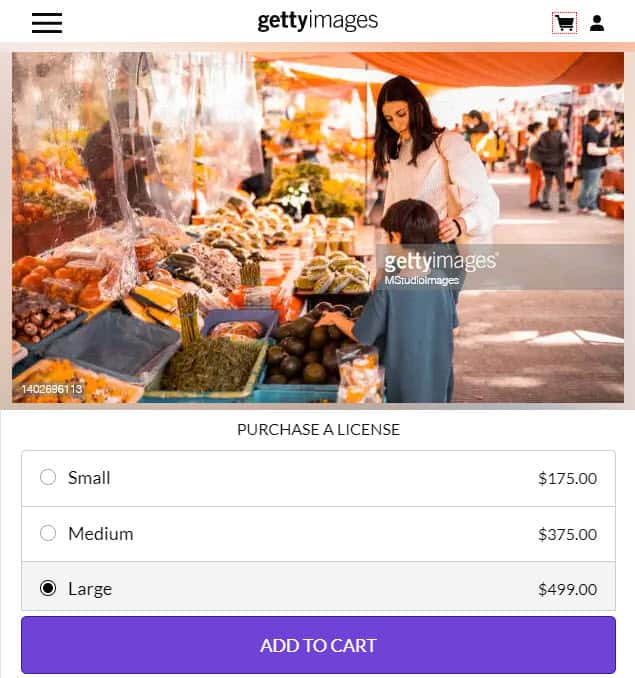
Donations
If you have a large audience, you can ask for donations from your readers.
This is a great way to monetize your travel blog if you are providing a lot of value to your readers and they are willing to support you.
You can set up a donation button on your website using a service like PayPal.
You can also ask your readers to support you on a platform like Patreon.

Sponsored Trips
If you have a large and engaged audience, brands may be willing to pay for you to take a trip and write about it on your blog.
This is a great way to monetize your travel blog if you are willing to do some work in exchange for a free trip.
You can contact brands directly and inquire about fully paid trip opportunities.

FAQ
Can you create a successful travel blog without traveling?
Yes, you can create a travel blog without traveling. You can write about your local area or about places that you have visited in the past. You can also start a travel blog without ever traveling. You just need to be good at research and writing. But it helps if you want to travel the world and have a passion for the travel blogging niche.
Do you need to be a good writer to start a travel blog?
No, you don’t need to be a good writer to start a travel blog from scratch. However, it is helpful if you can write clearly and concisely.
How do travel bloggers get paid?
There are several ways that travel bloggers get paid, such as through advertising, sponsorships, affiliate marketing, and selling products.
Do you need to be a good photographer to start a travel blog?
No, you don’t need to be a good photographer to start a travel blog. However, it is helpful if you can take clear and interesting photos.
Do you need a lot of money to start a travel blog?
No, you don’t need a lot of money to start a travel blog. You can start a blog for $4.3 a month with BlueHost.
How much time does it take to run a successful travel blog?
It takes a significant amount of time and effort to run a successful travel blog. You should expect to spend several hours per week working on your blog.
Can you make money from a travel blog without selling advertising?
Yes, you can make money from a travel blog without selling advertising. There are many other ways to monetize your website, such as selling products, affiliate marketing, and sponsored posts.
What Next?
Are you ready to ready to start a successful travel blog and become a successful travel blogger? Are you ready to start making money with your travel blog? Then follow this guide and get your travel blog up and running.
If you have any questions as you set up your new travel blog, leave a comment below so we can help you out.
Starting a travel blog is a great way to share your love of travel with the world and make a living. It takes time and effort to grow a successful blog, but it is definitely worth it to become a professional travel blogger!
We hope this guide has helped you to get started on your own travel blog.
Have you started your travel blog yet? What type of travel blog are you going to start? Let us know in the comments.
Share this post with your friends & followers:
